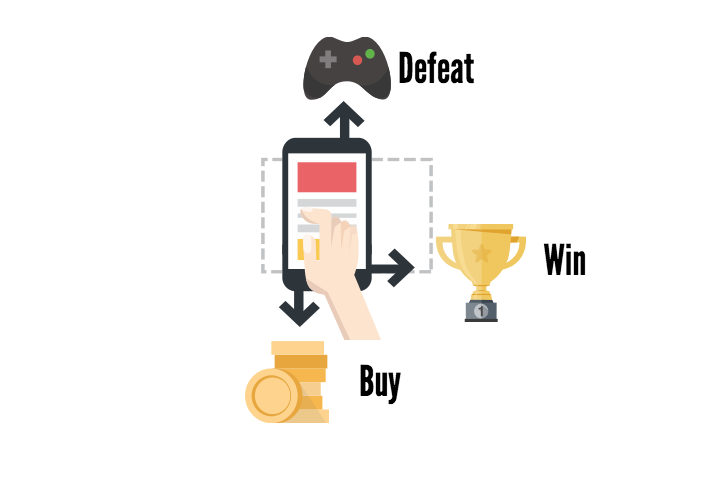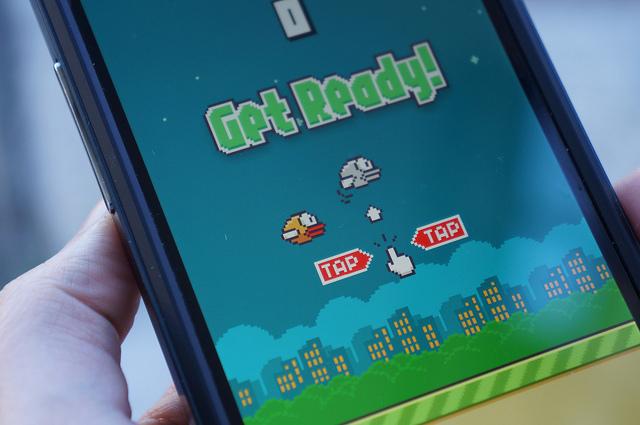uy, defeat, win. Buy, defeat, win. Buy, defeat, win. Over and over, you just keep repeating the same thing — buy, defeat, win. This is how games like Candy Crush, Clash of Clans and Angry Birds get you to spend hours and hours playing the game. Many mobile app companies have begun to incorporate similar patterns into their games. Psychological components made to get players addicted have changed the playing field of game design and dominated the face of trending entertainment.
COMPULSION LOOPS
Compulsion loops are a chain of activities repeated to gain some sort of reward. In the actual game, this may be some sort of virtual reward, like gold coins. But inside the brain, this turns into neuroc hemical rewards, such as dopamine, a neurotransmitter that helps to control the brain’s pleasure and reward centers. The act of releasing dopamine after performing a specific action basically tells your brain, “Hey, this action made you feel good. You should repeat this action again so.”
hemical rewards, such as dopamine, a neurotransmitter that helps to control the brain’s pleasure and reward centers. The act of releasing dopamine after performing a specific action basically tells your brain, “Hey, this action made you feel good. You should repeat this action again so.”
Drug addictions are formed l
ike this as well; drug intakes often increase levels of dopamine released, making the user feel pleasure, consequently driving them to take more drugs. And although it might feel scary to compare drug abuse to simple games on a phone, it’s scientifically undeniable that the two work on the same basis of repetition and reward. This is why these games can become so addictive, even to the point where it’s dangerous.
THE GOLDILOCKS CHALLENGE
While playing the game to win is incentive already, it’s when the game becomes just hard enough that we get really addicted.
“It’s that tension of knowing you might get the treat, but not knowing exactly when that keeps you playing,” Transmedia game designer Andrea Phillips said in an interview with The Next Web. This provides the explanation for many games, such as Flappy Bird, but also for recent trends, like the “water bottle flipping” craze that has been taking over social media.

Successfully flipping a water bottle may not reward you with gold coins like Flappy Bird does, but the satisfaction of succeeding after so many tries is enough to make you to want to try again. The prerequisites necessary for a flipped water bottle to land upright on a table makes the challenge just challenging enough for us to feel like we’ll get it the next time, or the next, or the next. We become gamblers, anxiously hoping that this will be our lucky time, this will be the time when we hit the lottery, the time when we win the slots machine, the time when we flip the bottle right.
THROUGH A GAME DESIGNER’S EYE
MVHS alumnus and current freshman at Laguna College of Art and Design Anthony Sun is an avid gamer and currently studying game design. He affirms that many games have repetitive, addictive components that act as incentives to keep playing. A majority of these components are progression systems built into the game that motivate players to continually play.
Though these components are a part of the game, to Sun, it’s the story told through the game that is most interesting.
“Even in games that encourage repetition, […] there’s still a story to be told and you’re telling that through the arc,” Sun said. “It doesn’t matter if the game is story-based or whatever because either way, it doesn’t matter, it’s still going to tell a story.”
Still, Sun believes that it is important to include aspects of repetition as it’s one of the many essential parts to game design.
“I want a game with good mechanics, good story – so it’s visually engaging as well as mechanically engaging,” Sun said. “I enjoy all aspects of it, I don’t think any of it is something you can neglect, if you want a good game.”
Together, the story and mechanics of a game work to make the perfect combination of addictive and engaging. According to Sun, without one or the other, the game wouldn’t be able to do well.
“Would you rather have eyes or a mouth?” Sun asked. “Because I believe all that is important. If you lose one aspect of it, it kind of all goes to sh*t.”
A PLAYER’S PERSPECTIVE
Junior Nathan Ma, who used to play games like League of Legends often a few years back, describes how he felt addicted to the games while he was playing them.
“I played League since, like, 6th grade for four or five years, and I didn’t play anything else. I just did that,” Ma said. “I felt like I just couldn’t stop […] it felt like an addiction for a while.”
Ultimately, Ma’s addiction was short lived.
“I just got bored of it and some friends stopped playing and once your friends stop playing, you don’t want to play with strangers anymore, so you stop,” Ma said.
Ma cites the repetition as the reason for quitting.
“Every match you play is really similar,he only difference is you’re playing against different people,” Ma said. “I guess sometimes things work out differently, but, yeah, it feels like it’s the same thing every time.”
In addition to boredom, Ma cites other drawbacks of game addiction.
“When I played, I sort of didn’t sleep very much,” Ma said. “I sort of just focused on that and my grades were really bad, and then I stopped freshman year.”





















